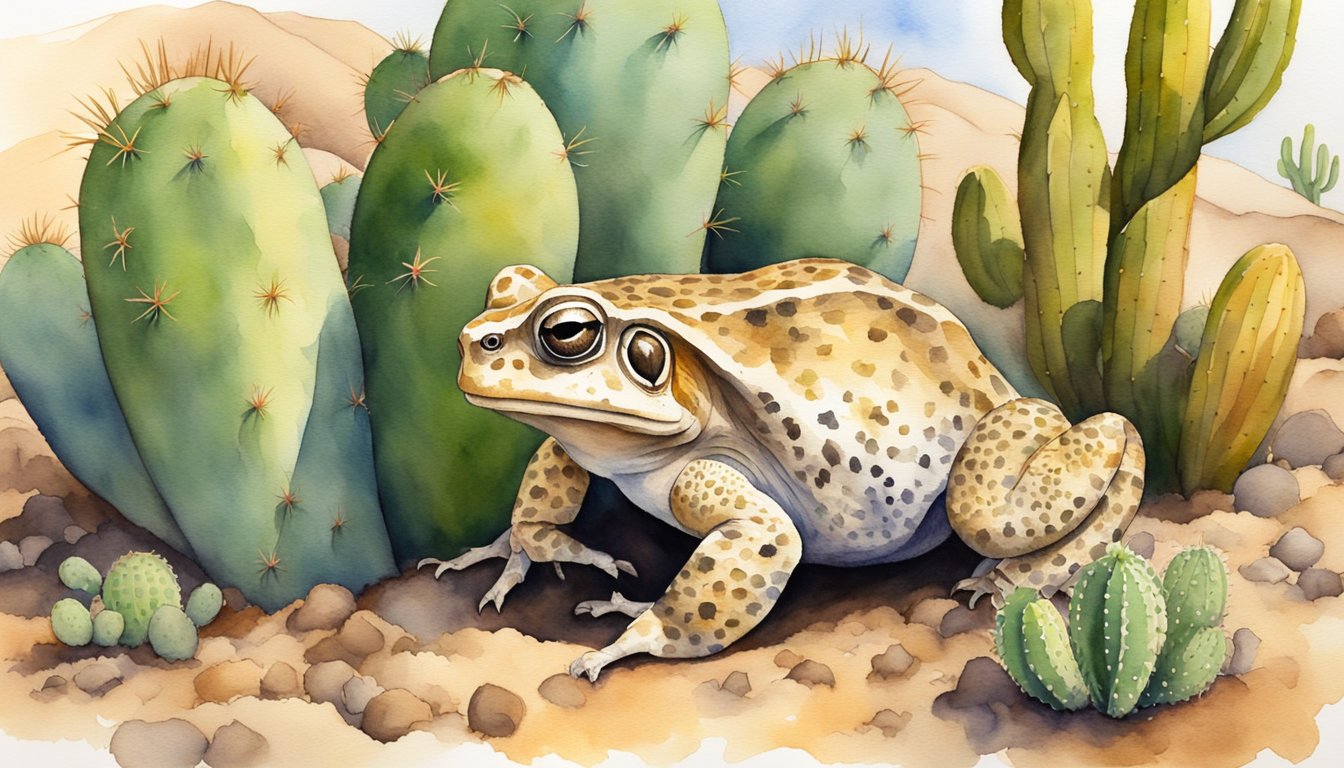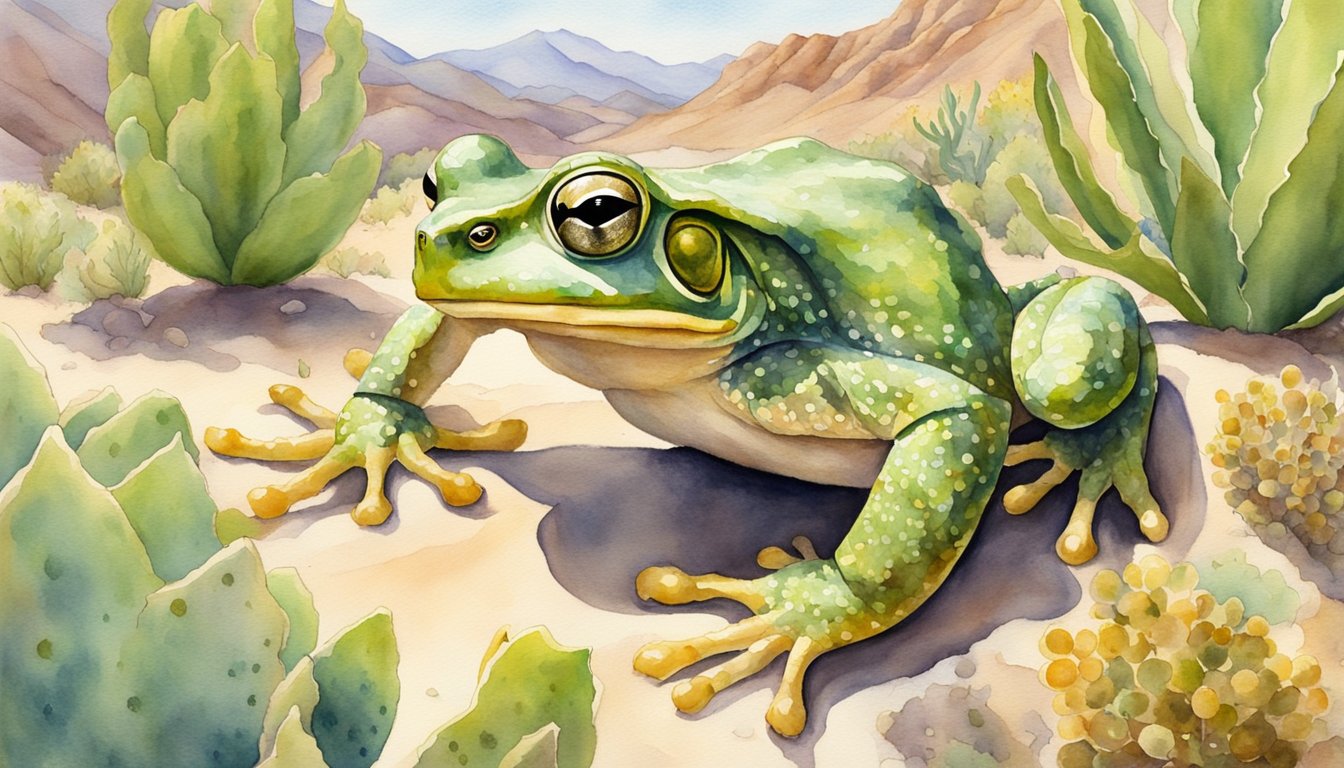Overview of the Sonoran Desert Toad
The Sonoran Desert Toad, known by its scientific name Incilius alvarius, is a fascinating creature native to the southwestern United States and parts of Mexico. With its distinctive features and unique habitat requirements, it makes an intriguing subject for study and conservation efforts.
Identification and Habitat
I. alvarius is also commonly called the Colorado River Toad. It is the largest toad native to North America, identifiable by its olive-green to brown skin, textured with warty bumps, and the large parotoid glands behind its eyes. These toads typically flourish in the Sonoran Desert’s semi-arid environment, where they seek out water sources such as rivers, temporary pools, and man-made reservoirs to breed and hydrate.
Habitat Range:
- Southwest United States: Arizona, New Mexico, California
- Northwestern Mexico: Sonora, Sinaloa
Key Adaptations:
- Burrowing behavior for estivation during hot weather
- Breeding after heavy rains, ensuring sufficient water for tadpole development
The habitat of the Sonoran Desert Toad extends from southwestern New Mexico to southeastern California, encompassing the lower regions of the Colorado River and often stretching into Sinaloa. These hardy toads have adapted to the harsh desert climate, often burrowing underground to escape the extreme heat and emerging during the rainy season to breed and feed.
Conservation and Significance
The conservation status of the Sonoran Desert Toad fluctuates as they face threats from habitat loss and environmental changes. As a member of the Bufonidae family, they play a significant role in the desert ecosystem as both predator and prey. Their presence indicates a healthy environment, which makes them important to regional biodiversity.
Notable Conservation Initiatives:
- Monitoring by the National Park Service and other organizations
- Habitat protection efforts within regions including Arizona and Sonora
While not yet considered endangered, the Incilius alvarius is a subject of interest for the National Park Service and other groups focused on conservation within the Southwest. Protecting its habitat from development and pollution is crucial for maintaining the delicate balance of the desert ecosystem they inhabit.
Read more about these intriguing amphibians and their role in the ecosystem through the National Park Service and enhance your understanding of their unique adaptation strategies and the importance of their conservation.
Ecology and Behavior

The Sonoran Desert Toad leads a secretive nocturnal life amid the diverse desert landscape, where its behaviors and interactions with the environment paint a compelling picture of adaptation.
Diet and Predation
The Sonoran Desert Toad has a diet primarily consisting of a variety of insects, spiders, and small mammals, including mice. They forage for food in the dark of night, using their expansive mouths to snap up prey. Predators of this toad can include snakes and various mammals, although their toxic secretions provide a significant defense against these threats.
Reproduction and Development
Reproduction for these toads is a synchronized event, often occurring shortly after the onset of the rainy season. They are drawn to temporary pools, streams, and canals created by rain where their distinct call can be heard as males attempt to attract females. The resulting larvae are fully aquatic and develop rapidly to cope with the ephemeral nature of their watery nurseries.
Defense Mechanisms
Sonoran Desert Toads are equipped with parotoid glands that secrete toxins as a defense against predators. These amphibians can also burrow into the sand or use rodent burrows to escape the harsh desert conditions and potential threats. Their defensive behavior is a key survival mechanism that deters many animals from preying on them.
Interaction with Humans

The Sonoran Desert toad encounters humans in various ways, often leading to complex outcomes. Some people seek out the toad for its psychoactive secretions, while its habitat faces pressure from human development and legal issues around its protection emerge due to its unique place in the ecosystem.
Substance Use and Effects
The bufotoxin produced by the Sonoran Desert toad contains compounds such as 5-MeO-DMT and bufotenin, which have hallucinogenic properties. The practice known as “toad licking” can lead to powerful hallucinations, as these substances act on the human brain’s serotonin receptors. However, consuming these toxins is highly risky and can result in serious poisoning. Notable figures like Mike Tyson have admitted to using toad venom, which has only increased its popularity among those seeking psychedelic experiences. Despite its famed use, it is illegal to harass or harm these amphibians, and organizations like the Tucson Herpetological Society emphasize the importance of these creatures beyond their psychedelic effects.
Environmental and Legal Concerns
With the rising demand for the toad’s hallucinogenic secretions, concerns about their conservation status and the impact on local ecosystems grow. The Sonoran Desert toad is not currently listed as endangered, but habitat destruction due to pesticide use and human expansion poses a threat to their longevity and reproduction. Pets such as dogs and cats may be fatally poisoned if they come into contact with the toad’s toxin, while animals like raccoons have learned to use the toad’s poison to their advantage. Legal authorities issue warnings against capturing or consuming these toads, advocating for their protection. Conservationists like Robert Villa of the Tucson Herpetological Society call attention to the toad’s role in the desert ecosystem and the broader impact of human interaction.

